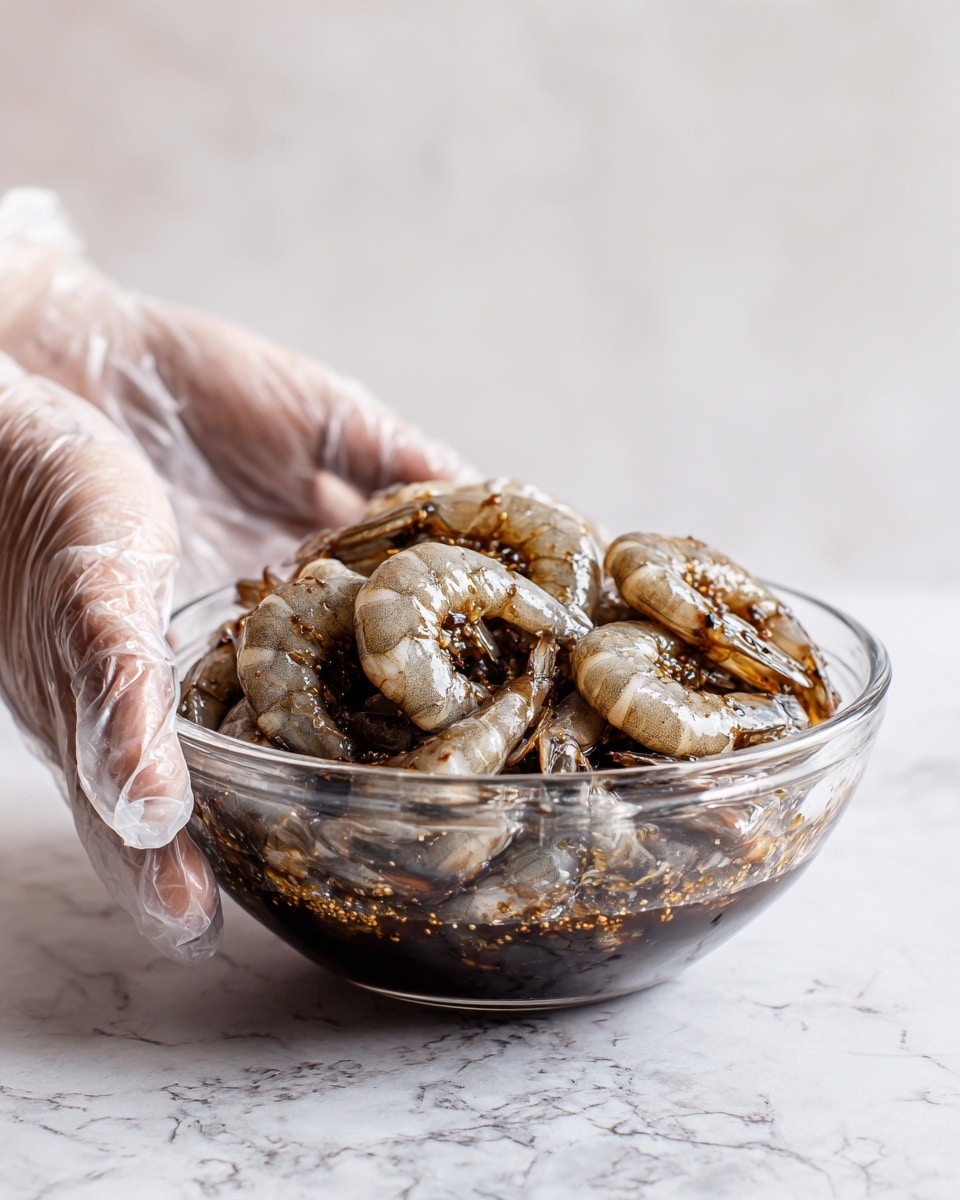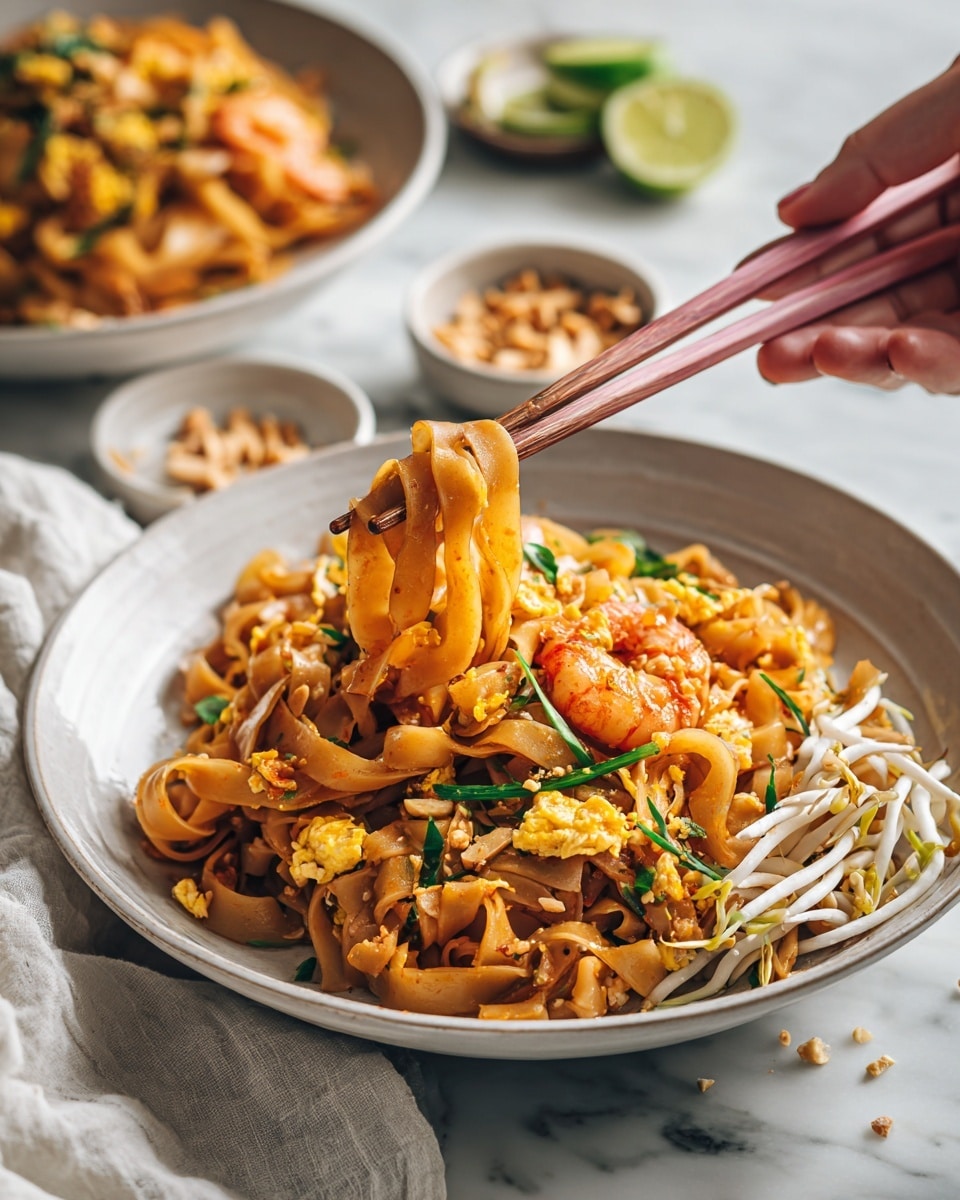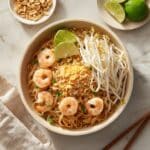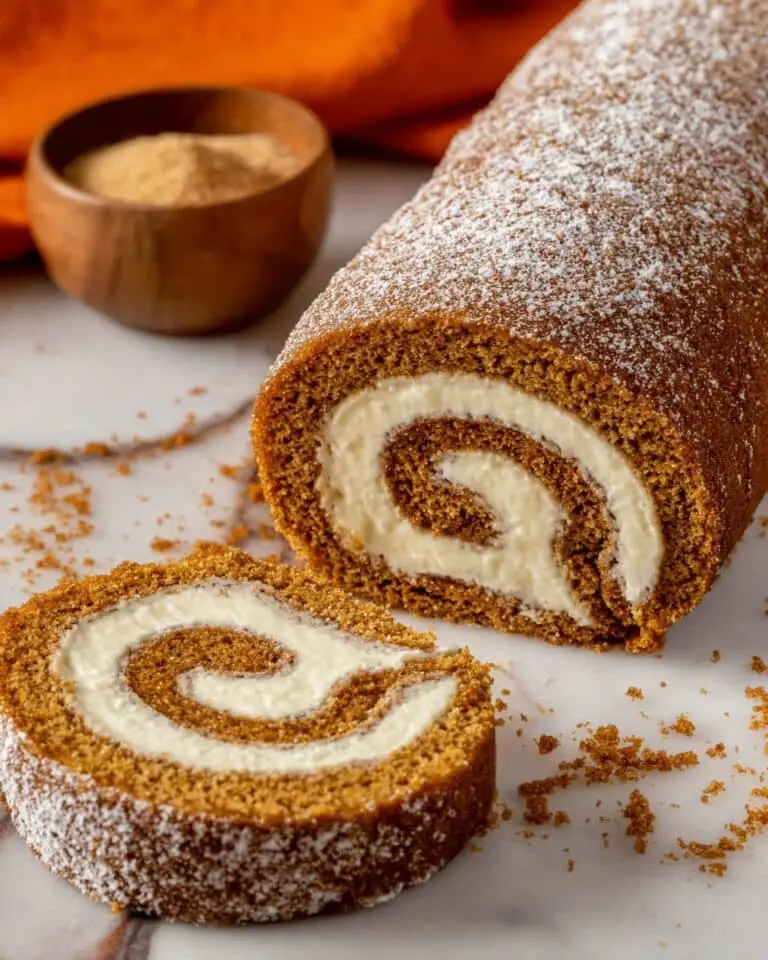If you have ever craved a meal that bursts with texture and flavor, the Classic Pad Thai Recipe with Shrimp and Tofu Recipe is your ticket to an unforgettable dinner table experience. This beloved Thai street food captures a vibrant harmony of tangy tamarind, savory fish sauce, crunchy peanuts, and the delightful contrast of plump shrimp and tender tofu. It’s a dish that feels comforting and exciting all at once, perfectly balanced with fresh bean sprouts and garlic chives, making every bite a celebration. Whether you’re a seasoned cook or just discovering Thai cuisine, this Classic Pad Thai Recipe with Shrimp and Tofu Recipe will quickly become one of your all-time favorite homemade dishes.
Ingredients You’ll Need

Getting the ingredients right is the secret to mastering the Classic Pad Thai Recipe with Shrimp and Tofu Recipe. Each component plays an essential role, bringing authentic flavors, varied textures, and beautiful colors to your plate — from the tangy tamarind, which gives the dish its signature zing, to the crunchy roasted peanuts that add a satisfying bite.
- Tamarind pulp: This provides the uniquely tangy base that defines the sauce and brightens the whole dish.
- Boiling water: Essential for dissolving the tamarind pulp into a smooth puree.
- Brown sugar (or palm sugar): Adds natural sweetness to balance the tamarind’s tartness.
- Fish sauce: Brings deep umami and savory notes that boost the overall flavor.
- Oyster sauce: Enhances the richness with its slightly sweet, briny complexity.
- Shrimp (peeled and deveined): Provides fresh, juicy seafood flavor and lovely color contrast.
- Thai soy sauce: Offers a subtle saltiness without overpowering the sauce.
- Pad Thai noodles: The soft, thin rice noodles that absorb all the delicious sauce perfectly.
- Garlic (minced): Adds a fragrant, savory base to the stir-fry.
- Shallots (minced): Give a sweeter, milder onion flavor and crunch.
- Firm tofu (thinly sliced): Adds protein and a soft texture that absorbs the sauce beautifully.
- Dried shrimp: Intensifies the seafood essence and adds umami depth.
- Eggs (whisked): Create a silky, rich binder that coats the noodles.
- Bean sprouts: Add a crisp freshness that balances the cooked ingredients.
- Garlic chives (cut into 1-inch pieces): Provide a mild garlicky aroma and vibrant green color.
- Roasted peanuts (crushed): Give satisfying crunch and nuttiness as topping.
- Lime wedges: Bring bright acidity for an extra pop at serving.
- Dried chili flakes: For those who love a touch of heat adding depth to each bite.
You’ll find the full ingredient list, instructions, and print option in the recipe card below.
How to Make Classic Pad Thai Recipe with Shrimp and Tofu Recipe
Step 1: Prepare the Tamarind Puree
Start by separating the tamarind pulp in a small bowl and mixing it with boiling water. Break up the pulp until it dissolves. Press this mixture through a fine-mesh strainer to get a smooth tamarind puree, which is the soul of your Pad Thai sauce. Its bright acidity will cut through the richness of other ingredients beautifully.
Step 2: Marinate the Shrimp
Next, toss the peeled, deveined shrimp with Thai soy sauce and fish sauce in a small bowl. This quick marinade ensures the shrimp is flavorful and juicy once cooked, infusing each bite with a savory depth that sings alongside the noodles and sauce.
Step 3: Make the Pad Thai Sauce
In a small bowl, combine the freshly made tamarind paste, brown sugar, fish sauce, and oyster sauce. Stir well until everything is blended perfectly into a balanced sauce that’s sweet, sour, and umami-rich—a magic elixir for your noodles.
Step 4: Cook the Noodles
Bring a pot of water to a boil and cook the Pad Thai noodles just until al dente. Quick cooking preserves their tender chewiness, which is so important to the authentic texture of this dish. Drain and set aside to be combined later with all the other luscious ingredients.
Step 5: Cook the Shrimp
Heat one tablespoon of oil in a wok or large skillet over high heat and sear the marinated shrimp for about 2 minutes on each side until pink and cooked through. Removing them now keeps the shrimp perfectly tender and prevents overcooking when you add them back later.
Step 6: Sauté Aromatics, Tofu, and Dried Shrimp
Using the same wok, add two tablespoons of oil and sauté minced garlic and shallots until fragrant and lightly caramelized. This step builds layers of flavor. Toss in the firm tofu slices and dried shrimp, letting them soak up those aromatic oils for about 2 minutes, creating a delicious centerpiece for the dish.
Step 7: Add Eggs, Noodles, and Sauce
Push your ingredients to one side of the pan, add a little more oil, and pour in the whisked eggs. Scramble gently until just set, then add the noodles and pour over the prepared Pad Thai sauce. Toss everything together carefully so the noodles absorb the flavors and the eggs coat the mixture with silkiness.
Step 8: Finish with Shrimp and Fresh Ingredients
Turn off the heat and gently fold in your cooked shrimp, crisp bean sprouts, chopped garlic chives, and crushed roasted peanuts. This fresh addition adds textural contrast and vibrant flavor notes essential to authentic Pad Thai.
Step 9: Serve Immediately
Plate your creation and top with extra crushed peanuts, fresh bean sprouts, lime wedges, and a sprinkle of dried chili flakes. The lime brings refreshing brightness while the chili flakes add a mild kick—personalize it as you like for the perfect finish to your Classic Pad Thai Recipe with Shrimp and Tofu Recipe.
How to Serve Classic Pad Thai Recipe with Shrimp and Tofu Recipe

Garnishes
Classic Pad Thai garnishes make all the difference. Fresh bean sprouts add crispness, while lime wedges provide a necessary zesty pop at the table. Crushed roasted peanuts contribute a crunchy, nutty topping, and chili flakes offer customizable heat. Garlic chives not only lift the aroma but also add a subtle garlicky freshness for an extra layer of flavor and visual appeal.
Side Dishes
Though Classic Pad Thai with Shrimp and Tofu is a full meal on its own, pairing it with light sides like a simple cucumber salad or steamed greens can cool and complement its bold flavors. A bowl of clear broth or a Thai iced tea will balance the meal perfectly, keeping your palate refreshed throughout.
Creative Ways to Present
For an impressive dinner presentation, serve Classic Pad Thai Recipe with Shrimp and Tofu Recipe in shallow bowls topped with a fan of lime wedges and a sprinkle of herbs. Adding edible flowers or a side of fresh Thai basil can elevate the visual appeal. Alternatively, pile it high on a large platter to encourage serving family-style, making it a friendly and shareable centerpiece for your meal.
Make Ahead and Storage
Storing Leftovers
Leftover Classic Pad Thai with Shrimp and Tofu stores well in an airtight container in the refrigerator. To preserve the texture, especially of the noodles and tofu, enjoy within 2 days for the best taste and freshness. Store garnishes like peanuts and lime wedges separately to keep them crunchy and vibrant.
Freezing
While freezing is possible, it’s best to avoid it for this recipe as the noodles and tofu can become mushy upon thawing. If you must freeze, separate the noodles from the sauce and store in airtight containers, but know the texture might change, which could affect the overall enjoyment of your Classic Pad Thai Recipe with Shrimp and Tofu Recipe.
Reheating
Reheat leftovers gently in a skillet over medium heat with a splash of water or oil to prevent sticking and to revive the noodles’ softness without drying out the tofu or shrimp. Avoid microwaving for long periods as this can make noodles rubbery. Stir often and reheat until warmed through, then add fresh garnishes to revive that just-cooked brightness.
FAQs
Can I use chicken instead of shrimp in this Classic Pad Thai Recipe with Shrimp and Tofu Recipe?
Absolutely! Chicken breast or thigh slices work wonderfully as a swap and will soak up the sauce beautifully. Just cook them thoroughly before adding to the noodles and follow the same marinating and cooking steps for balanced flavor.
Is it possible to make this dish vegetarian?
Yes, for a vegetarian version, simply omit the shrimp and dried shrimp, and replace fish and oyster sauces with vegetarian alternatives like soy sauce and mushroom sauce. The tofu and sauce will still make a very satisfying and authentic-tasting Pad Thai.
What is the key to getting the Pad Thai noodles just right?
The noodles should be cooked al dente, then quickly drained and set aside. Overcooked noodles can become soft and mushy when stir-fried. Using fresh, quality rice noodles also makes a big difference for the ideal chewiness and mouthfeel.
How spicy is this Classic Pad Thai Recipe with Shrimp and Tofu Recipe?
The base recipe is mildly spicy, but the dried chili flakes served on the side let you customize your heat level. You can add them according to your preference, making it perfect for everyone, from mild to spicy-food lovers.
Can I prepare parts of this recipe in advance?
Yes! You can prepare the tamarind sauce, marinate the shrimp, and chop your vegetables ahead of time. Cook the noodles just before serving for best texture. This approach saves time and makes the cooking process much smoother.
Final Thoughts
This Classic Pad Thai Recipe with Shrimp and Tofu Recipe is a true celebration of flavors that captures the spirit of Thai cooking—fresh, bold, and irresistible. Once you try making it yourself, you’ll appreciate how accessible authentic tastes can be from your own kitchen. So don’t hesitate: gather your ingredients, follow the steps, and enjoy the magic of this incredible dish any night of the week!
PrintClassic Pad Thai Recipe with Shrimp and Tofu Recipe
This authentic Pad Thai recipe delivers a perfect balance of tangy tamarind, savory fish sauce, and sweet palm sugar combined with tender shrimp, tofu, and rice noodles. Garnished with crunchy peanuts, bean sprouts, lime, and chili flakes, it’s a classic Thai street food favorite that’s quick to prepare and bursting with vibrant flavors.
- Prep Time: 10 minutes
- Cook Time: 20 minutes
- Total Time: 30 minutes
- Yield: 3 servings
- Category: Main Course
- Method: Stovetop
- Cuisine: Thai
Ingredients
Pad Thai Sauce
- 3 tablespoon Tamarind pulp (about 1.5 oz)
- 1/4 cup boiling water (or more if needed)
- 1/4 cup brown sugar (or palm sugar)
- 2 tablespoon fish sauce
- 2 tablespoon oyster sauce
Protein & Noodles
- 8 oz shrimp (peeled and deveined)
- 1 teaspoon Thai soy sauce
- 1 teaspoon fish sauce
- 6 oz pad Thai noodles
- 3 oz firm tofu (drained and cut into thin slices)
- 2 tablespoon dried shrimp
- 2 eggs (whisked)
Aromatics & Vegetables
- 4 cloves garlic (minced)
- 1/3 cup shallots (about 3 shallots minced)
- 2 cups bean sprouts (loosely packed)
- 10 garlic chives (cut into 1-inch pieces)
Garnishes
- 2 tablespoons roasted peanuts (crushed)
- Lime (wedge cut)
- Dried chili flakes
Instructions
- Prepare Tamarind Paste: Separate the tamarind pulp by mixing it with 1/4 cup boiling water in a small bowl. Break up the pulp in the hot water, then press the mixture through a fine-meshed strainer to remove solids, yielding about 1/4 cup of tamarind puree.
- Marinate Shrimp: In a small bowl, combine the shrimp with light soy sauce and fish sauce. Mix well and set aside to marinate briefly.
- Make Pad Thai Sauce: In another small bowl, mix tamarind paste, brown sugar, fish sauce, and oyster sauce until well combined. Set aside.
- Cook Noodles: Bring a medium pot of water to a boil. Cook the pad Thai noodles until al dente according to package directions. Drain and set aside.
- Cook Shrimp: Heat one tablespoon of cooking oil in a wok or large non-stick skillet until hot. Add shrimp and sear on each side until pink and cooked through, about 2 minutes per side. Remove shrimp and set aside.
- Sauté Aromatics, Tofu, and Dried Shrimp: In the same skillet, add two tablespoons of cooking oil over medium heat. Sauté minced garlic and shallots until fragrant and lightly browned, about 2 minutes. Add tofu slices and dried shrimp, tossing gently for another 2 minutes to combine flavors.
- Cook Eggs and Combine: Push ingredients to one side of the pan, add one tablespoon of cooking oil, and pour in beaten eggs. Scramble the eggs gently for about 30 seconds until lightly cooked. Next, add noodles and the prepared sauce and toss together gently to evenly coat noodles with sauce.
- Combine Shrimp and Vegetables: Turn off the heat. Add cooked shrimp, bean sprouts, garlic chives, and crushed roasted peanuts. Toss gently to combine all ingredients without overcooking the vegetables.
- Serve: Plate the Pad Thai immediately and garnish with additional crushed peanuts, bean sprouts, lime wedges, and dried chili flakes to taste. Enjoy your flavorful homemade Pad Thai!
Notes
- Adjust tamarind water quantity as needed to achieve the right balance of tanginess.
- Use palm sugar for a more authentic sweetness if available.
- Cook noodles until just al dente to prevent over-softening in the pan.
- Be careful not to overcook eggs; they should remain soft and slightly creamy.
- Optional: substitute shrimp with chicken or keep it vegetarian by omitting seafood and using extra tofu.
- For milder flavor, reduce or omit dried chili flakes.








